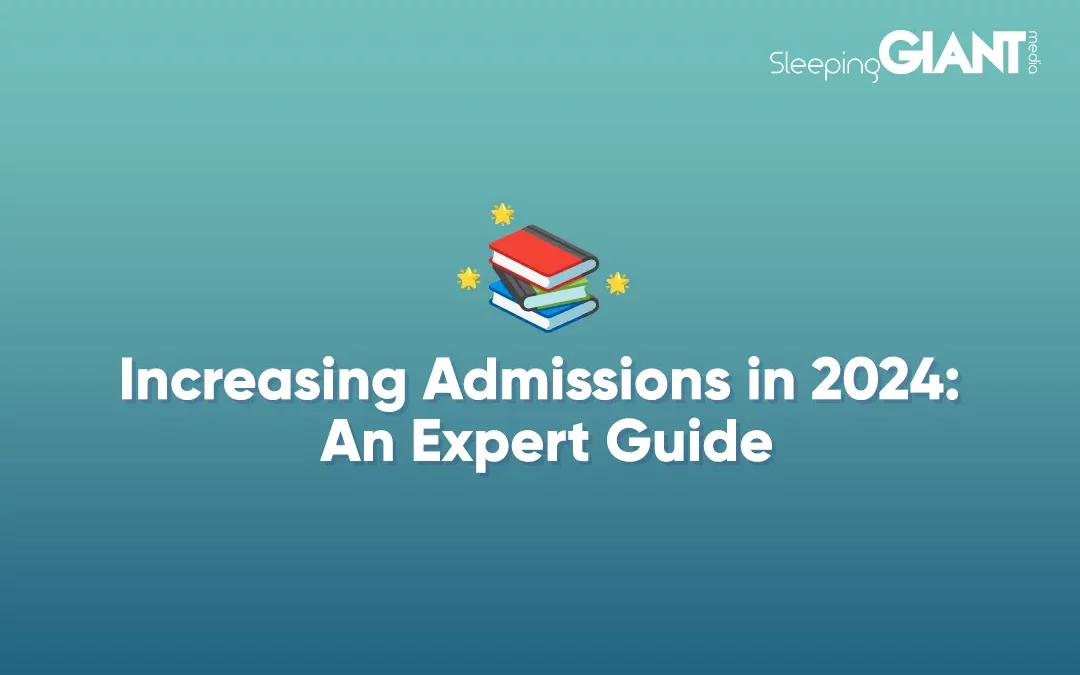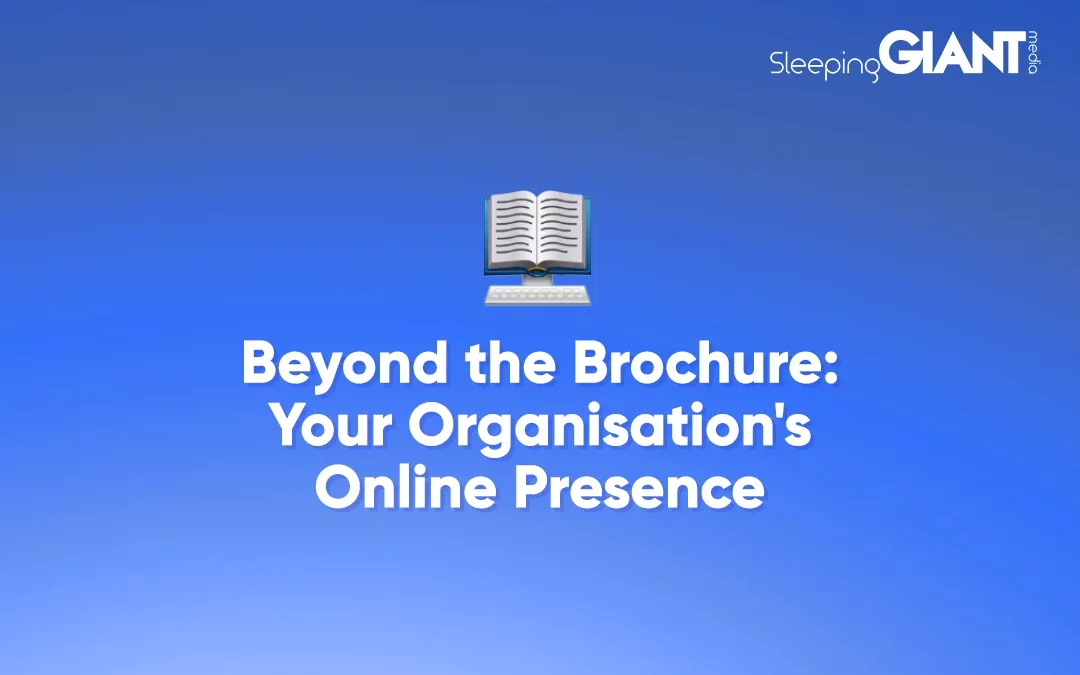We knew it wouldn’t be long before Google released their first core update of...

Increasing Admissions in 2024: An Expert Guide
Increasing Admissions in 2024: An Expert Guide
2024 is set to be another challenging and changeable year for independent schools. But, don’t worry, there are plenty of ways to stay ahead of the curve — namely, by leveraging strategy and insight to your advantage.
In our latest webinar, CEO, Luke Quilter, sat down with Christina Adamopoulou, Head of Marketing and Communications at TASIS England, to discuss the challenges and possible solutions to navigating marketing in the private schools sector in 2024.
Joined by our Lead Account Manager, Lauren Hearnden, they unpacked the actionable insights that can be utilised to empower marketing teams and drive results in the competitive education sector.
If you missed the webinar, don’t worry. We’ll take you through everything that was mentioned in this blog.
Leveraging marketing strategy to increase admissions
In our work with some of the world’s leading independent schools, we’ve seen several recurring challenges over the years — and increasing admissions has undoubtedly been one of the most prominent. As Christina put it, for independent schools, “it all boils down to bringing students in. That’s where marketing and meetings come in, and it’s a significant challenge”.
But how?
During our discussion with Christina, we posed this question — and it sparked a fruitful conversation. While you can watch the discussion unfold in full in the video at the bottom of this blog, here is a summary of our core discussion points. To make sure that your marketing efforts are achieving the top results, the following areas of focus are essential.
Right audience, right messaging
Marketing to individuals of any age isn’t easy — but an audience of parents and children is unique in its demands, restrictions, and targeting technicalities. In particular, crafting marketing campaigns that effectively engage parents of children in younger years seems to be a sticking point.
On this, Christina had the following to say,
“Many schools struggle with recruitment in early years and lower school. Parents often see senior school as more critical for preparing their kids for university, without understanding the importance of foundational years.”
And to remedy this?
“Schools need to communicate the value of these early years in helping children achieve their university and career goals. They should also communicate their flexibility to meet parents’ needs, like wraparound care or bus services, which have become more important post-pandemic.”
That being said, it becomes clear that, in order to be successful in their efforts, schools must profile the features that their specific audience most wants to see. As an example, schools should explain how they provide services that support parents’ work-life balance, reflecting the changes in family dynamics post-pandemic.
Should schools market to children?
A unique challenge facing school marketing teams is that, at least in part, their target audience is made up of children. So, getting the balance between content that resonates with young people, but is designed to reach parents first, is difficult to navigate, to say the least.
During our webinar, we had a thought-provoking question from one of our attendees, asking how to navigate this considering the age restrictions of targeted social advertising on platforms like Snapchat, TikTok, Meta, YouTube, Threads, and Google.
In response, Lauren addressed this tricky balancing act, saying:
“Your messaging should resonate with parents, but be appropriate for younger audiences who may inadvertently come across it. We wouldn’t necessarily recommend actively targeting young people, but rather focusing on engaging content that speaks to parents. The messaging should be representative and resonate with parents, understanding that some elements might be seen by younger audiences. It’s about balancing compliance with engaging content. It’s more about laying the foundations for long-term engagement, with messaging that appeals to parents rather than younger audiences.”
And, of course, young people should not be on these platforms, but we know the reality is different. So, we need to be mindful of this in our marketing, creating content that is compelling to both adults and younger audiences.
Understanding demographics
On a wider scale, to run successful marketing activity in the private schools sector, you must also understand demographics. While it sounds far-fetched, changes in demographics such as birth rates do have implications for things like strategic planning.
Research and market analysis are key here. It’s important to look at population trends, relocation patterns, birth rates, and other demographic factors. Forecasting over different periods, like five or ten years, can give varied perspectives. Market analysis is crucial, and while it can be costly, there are resources available that can assist marketing managers in understanding local dynamics.
Christina’s top tips on demographic targeting are below:
Understanding what’s happening in your catchment area or, for international schools, the global dynamics, is vital. Conflicts and other global events can affect recruitment. This analysis feeds into strategic decision-making and might even influence program development based on projected demographic changes.
Regular market research and a deep understanding of local and global trends are essential for adapting strategy to demographic shifts. This might lead to program changes or strategic shifts to accommodate changing student numbers.
Adapting to economic changes & challenges
If you’re a private school in the UK, there are significant conversations underway at the moment about the upcoming elections and their impact on educational policy. In particular, regarding Labour’s potential imposition of VAT on independent schools’ fees.
To put it simply, if Labour does come into power, they’re likely to impose VAT on admission fees, which would make them more expensive and, potentially, shrink the market. For independent schools, these changes could make the market far more competitive, with potential consequences at all scales. As Christina put it, “I think everyone in the independent sector, from finance to marketing and admissions teams, is working on plans to mitigate the risks arising from this potential change”.
Should this change occur, how best can businesses in the independent schools sector respond? The solution? Prioritising differentiation — or, rather, what makes your school stand out.
Prioritising differentiation
If the market is likely to become more competitive, independent schools will need to work harder when it comes to effectively communicating what makes them different to their audiences. Drawing on her experience working with 43 independent schools across the globe, Lauren had the following to say:
“If the market shrinks, you really need to determine how to position yourself in a competitive landscape. Schools already talk about their academic excellence, which is a key part of their proposition. The challenge is differentiating your school from competitors talking about the same thing. It’s critical to have a clear, unique value proposition that fits into your strategy consistently, varying it based on the different needs of year groups and what parents are looking for.”
Lauren continued,
“It’s important to think about what makes your school unique and clearly define that. Your value proposition may vary depending on the year groups you’re targeting, as parents’ needs differ. Making sure you have a well-defined identity for your school is key, and it should be a consistent part of your communication strategy.”
AI in the classroom? Embracing new technologies
One of the most effective ways for a school to differentiate itself from the competition is through thought leadership and, of course, innovation.
AI is becoming increasingly relevant. It’s moving beyond just a buzzword and is something we as marketers and business leaders must embrace, as it’s going to be part of our future. And, when it comes to standing out from the competition as an independent school, AI has the potential to play the starring role. When asked about this, Christina reflected:
“Families use AI to search for schools. They might ask their devices questions about local schools or how to find the right school for their child. We need to be prepared to answer these questions and understand how to use AI to differentiate ourselves effectively.”
You can use technology to personalise your independent school’s interactions without making them seem automated. There are tools out there that can help with this, and that’s how you can differentiate.
Upskilling
It’s safe to say that keeping up with the latest advancements in technologies such as AI — let alone how they can be effectively harnessed to awaken potential in the independent schools sector — is challenging.
This is why Lauren recommends that independent schools consider training and upskilling as a core feature of any working relationship they may have with a marketing agency. As Lauren says,
“The key is focusing on the most crucial tactics and channels for each level, rather than attempting to address an overwhelming array of marketing activities. Training can support the understanding and implementation of these strategies.
Strong in-house marketing teams, whether at a school or group level, are crucial. And Foundational training enables these teams to collaborate more effectively with marketing agencies, building strategic partnerships with agencies and ensuring a better understanding and implementation of marketing ideas.”
Utilising video content and social media engagement
Another essential way in which marketers in the independent schools sector can reach more audiences with the view to increasing admissions is through video content and social media platforms. Visual content on platforms like TikTok and YouTube can be a significant part of the marketing funnel, attracting potential students’ attention.
The rise of short-form video content, especially on platforms like TikTok, was discussed as a major trend by our experts. Let’s take a look at what was said.
A spotlight on TikTok
Using TikTok is a great example of leveraging newer technology platforms. It’s essential to understand the demographics of these platforms. Millennials, now parents, are a significant audience on these platforms. Using platforms like TikTok effectively involves considering the types of content that will engage this demographic, while also keeping in mind necessary safeguards.
Platforms like TikTok are valuable for reaching the right audience for your school. However, there are safeguards to consider in using these platforms, like turning off comments on TikTok content.
Your independent school being active on TikTok could also serve as a differentiator. The demographics on platforms like TikTok are shifting, making them suitable for marketing to parents. So, TikTok could be a good platform for starting the journey with parents.
Christina had the following to say about the use of TikTok as a marketing method in her school:
“I’ve become an advocate for TikTok in my school. We can’t ignore that TikTok has become a significant search engine, even surpassing Google in search volume last year. It’s widely used by younger generations and millennials as a search tool, not just for entertainment. For marketing managers, remember you have resources within your school – your students – who can create user-generated content for platforms like TikTok.’
In the next few years, TikTok could become a primary channel for our target audience, and as marketers in this sector, we need to be prepared for that.
Utilising events and webinars effectively:
One of the most tangible or ‘visible’ ways to drive engagement is, of course, through the use of events and webinars — the latter becoming all the more popular since the pandemic.
Christina reflects on her learnings when it comes to utilising events and webinars in her school’s content strategy (especially considering the changes in trends over the last couple of years):
“During the pandemic, we shifted to virtual open days and events, evolving to a more conversational and interactive format. Now, our open days are more well-attended, indicating people’s desire for personal interaction and seeing the school firsthand.
We’ve learned not to shy away from aggressive marketing for events and to mix channels each time for maximum reach.”
For webinars, the recording and repurposing of content like blogs and case studies, along with personal interactions with admissions staff, students, or parents, is crucial. Continuing the conversation outside the event is important.
But with an increased importance of things like events comes the challenge of attribution — bringing us conveniently onto our next point.
Focus on ROI and data-driven marketing
One of the biggest challenges when it comes to marketing in the private school sector is understanding which efforts are most effective. It’s often not clear-cut if it was a particular ad or a combination of different media that influenced attendance. If you can track offline activities, like using QR codes on print media, you can gather more data on how people are finding out about your events.
Here are a few top tips from Christina & Lauren on tracking:
- Attributing success to specific marketing tactics can be difficult, but adding tracking elements like QR codes to offline media can provide valuable insights.
- UTM codes are useful for tracking the source of website visits, helping to identify which marketing efforts are driving traffic and where the traffic is coming from.
So, there you have it. A guide to striking the balance between innovation, commercialisation, and marketing in the independent school’s sector — straight from the experts themselves.
Are you a visual learner?
If you’re more of a visual learner, you can access a recording of our Increasing Admissions webinar to watch for free here.
Awaken your potential in education
For more expert guidance on how to awaken your potential when it comes to marketing for independent schools, we have quite an array of helpful resources in our toolkit. Simply navigate to our blog or any one of our How To guides. Or — for any specific questions — reach out to our team of experts today to start the conversation about your independent school’s marketing strategy.
Blog
Giant Wednesday
How To Optimise Images For Websites
Digital Marketing, technology & business insights, how-to's and explainer...
Follow Us
Sign Up For More
Stay up to date with the latest happenings, learnings, events & more with our GIANT Newsletters.
Contact Us
Top Floor, The Civic Centre, Castle Hill Avenue, Folkestone CT20 2QY.





